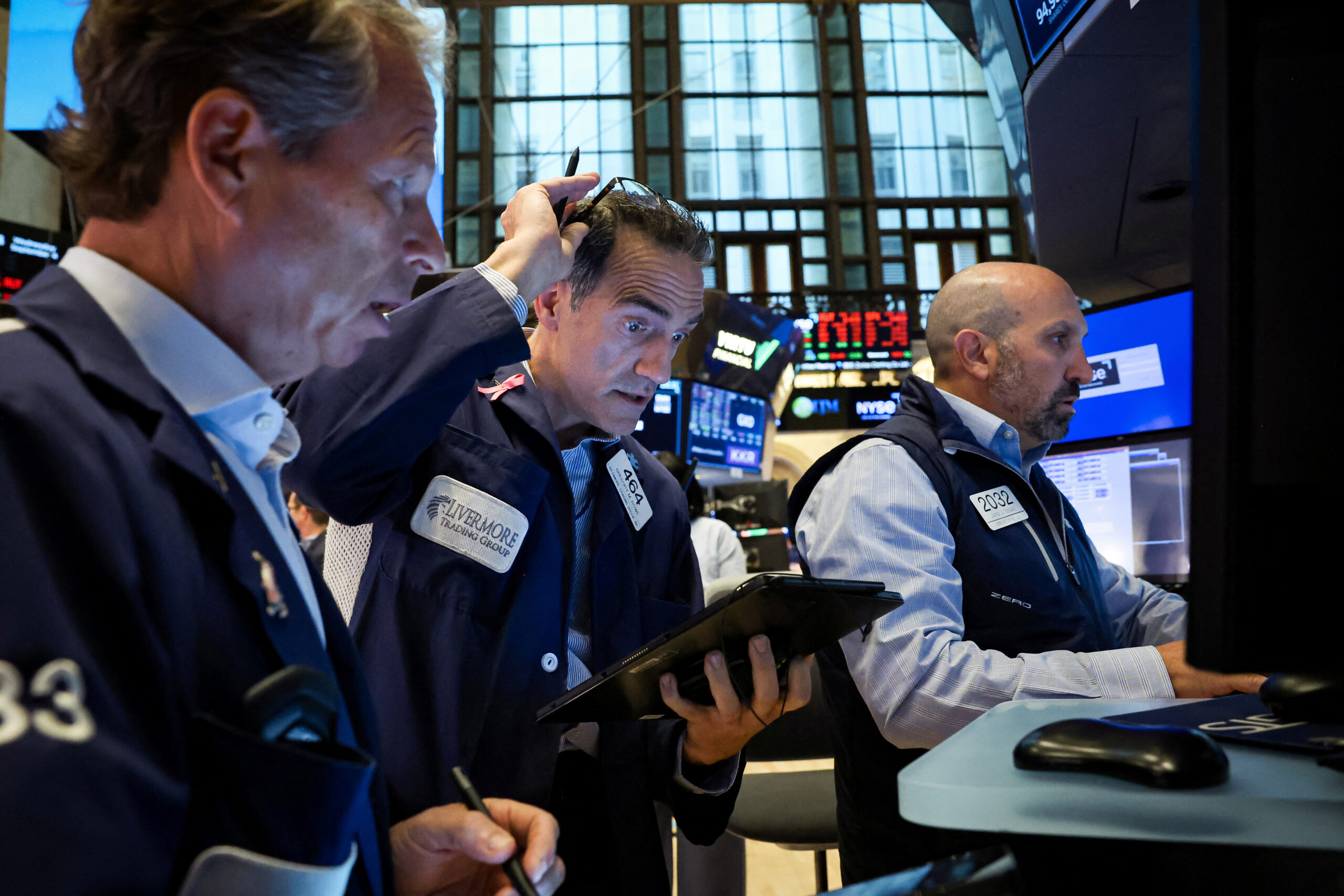A look at the day ahead in U.S. and global markets.
Wall Street futures have found their feet after Friday’s exaggerated market reaction to an otherwise middling employment report – with Apple’s new iPhone and Tuesday’s presidential candidates’ debate next up on the radar.
The August payroll report was modestly weaker than forecast, even if a significant improvement in July. Downward revisions to prior months softened the picture a bit more.
But the report was neither strong enough to completely dispel slowdown and recession fears for next year nor was it seen to be weak enough to nudge the Federal Reserve into a jumbo 50-basis-point interest rate cut this month.
Top Fed policymakers Christopher Waller and John Williams underscored expectations that a September 18 cut is coming – the former even said the easing cycle should be ‘frontloaded’. But neither seemed panicked enough to suggest 50 bps was needed yet.
By the close, the S&P500 was down 1.7% – clocking a 4.5% loss for the week that now stands as its worst since March 2023 and underlines yet again the seasonal downdraft that typically comes with September.
Following suit in a more measured fashion, Asian markets slipped early on Monday too.
And yet despite markets scaling back the expected size of this month’s Fed rate cut, there’s been no change to 112 bps of Fed rate cuts priced in by year-end, nor the 235bps seen over the next 12 months.
Ten-year Treasury yields hit on Friday their lowest since June last year and two-year yields their lowest since March 2023. Both firmed up a tad on Monday ahead of the week’s auctions of $119 billion of 3-, 10- and 30-year Treasury coupons.
U.S. stock futures and European bourses bounced back smartly today ahead of another crammed week – a likely second European Central Bank rate cut of the year on Thursday, Apple’s release of its new AI-infused iPhone on Monday and Tuesday’s televised face-off in the White House race.
The euro was on the back foot ahead of the ECB decision, with likely cuts to the central bank’s GDP and inflation forecasts on Thursday keeping some hopes alive of a third rate reduction as soon as next month.
Even though the Fed seems to have pivoted clearly toward the employment side of its dual mandate rather than the inflation one, the August CPI inflation report on Wednesday will be important to assess the degree of ongoing disinflation.
On that score, the deflationary pressures from overseas remain powerful, with China recording deep annual producer price deflation of 1.8% once again last month and a meager consumer price inflation rate of just 0.6% that also missed forecasts.
Commodity markets are doubling down on that disinflation. Even though oil prices had a toehold on Monday, U.S. crude remains below $70 per barrel after hitting a 15-month low on Friday and is still recording year-on-year declines of more than 20%.
U.S. market inflation expectations are evaporating fast.
The 10-year ‘breakeven’ inflation view embedded in inflation-protected Treasuries is now at just 2.04% – its lowest since January 2021. The two-year equivalent is just 1.87% – well below the Fed’s 2% target and raising the risk that significant undershoot of that goal may be in store.
The New York Fed publishes its August survey of household inflation expectations later on Monday.
Back in politics, the U.S. election race heats up again this week with Tuesday’s first televised debate between U.S. Democratic presidential candidate Kamala Harris and Republican challenger Donald Trump.
The stakes remain high as national opinion polls show the two neck and neck again after a brief period in which Harris gained the ascendancy following her nomination.
A poll conducted by The New York Times and Siena College released on Sunday showed the two effectively tied, with Trump up one percentage point – 48%-47% – over Harris.
The PredictIt betting site has them in a dead heat again too.
In Europe, former ECB chief and Italian Prime Minister Mario Draghi delivered his long-awaited report into reforming Europe’s economy, urging the European Union to adopt a more coordinated industrial policy, more rapid decisions, and massive investment if it’s to keep pace with the United States and China.
In company news, all eyes will be on Apple’s (NASDAQ: AAPL) new iPhone series later on Monday. Its stock was indicated up 1.6% ahead of the bell, alongside most of the other Big Tech megacaps.
The Financial Times newspaper reported on Saturday that the latest iPhone’s A18 chip, which is set to be unveiled at Monday’s event, has been developed using Arm’s newest V9 chip design.
And Boeing (NYSE: BA) shares rose 3% in U.S. premarket trading after the planemaker reached a tentative deal with a union in the U.S. Pacific Northwest that could avoid a possible crippling strike later this week.
Key developments that should provide more direction to U.S. markets later on Monday:
* New York Fed’s inflation expectations survey, US August employment trends, July consumer credit; Mexico August inflation
* Apple unveils new iPhone series
* US corporate earnings: Oracle (NYSE: ORCL)
* US Treasury sells 3-, 6-month bills
(Source: ReutersReuters)
Edward Cooke is a financial analyst, freelance writer, and editor. He has six years of experience in financial journalism. He has an in-depth understanding of equities markets, tracking major indices and providing real-time analysis on stock price movements, corporate earnings, and market sentiment. Read Full Bio










